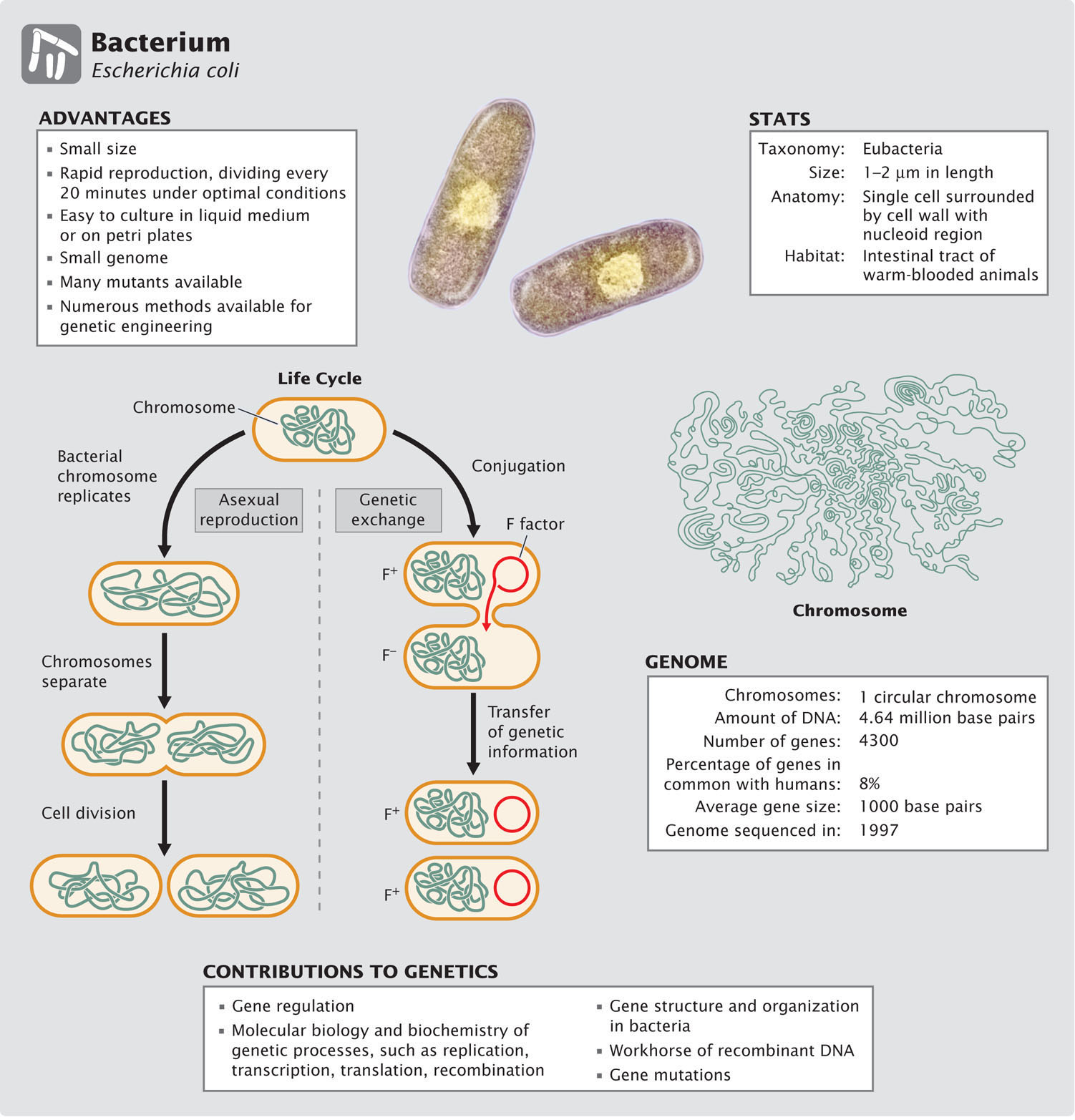The Bacterium Escherichia coli
The most widely studied prokaryotic organism and one of the best genetically characterized of all species is the bacterium Escherichia coli. Although some strains of E. coli are toxic and cause disease, most are benign and reside naturally in the intestinal tracts of humans and other warmblooded animals. E. coli was first described by Theodore Escherich in 1885 but, for many years, the assumption was that all bacteria reproduced only asexually and that genetic crosses were impossible. In 1946, Joshua Lederberg and Edward Tatum demonstrated that E. coli undergoes a type of sexual reproduction; their finding initiated the use of E. coli as a model genetic organism. A year later, Lederberg published the first genetic map of E. coli based on recombination frequencies and, in 1952, William Hays showed that mating between bacteria is asymmetrical, with one bacterium serving as genetic donor and the other as genetic recipient.
Advantages of E. coli as a model genetic organism
Escherichia coli is one of the true workhorses of genetics; its twofold advantage is rapid reproduction and small size. Under optimal conditions, this organism can reproduce every 20 minutes and, in a mere 7 hours, a single bacterial cell can give rise to more than 2 million descendants. One of the values of rapid reproduction is that enormous numbers of cells can be grown quickly, and so even very rare mutations will appear in a short period. Consequently, numerous mutations in E. coli, affecting everything from colony appearance to drug resistance, have been isolated and characterized.
Escherichia coli is easy to culture in the laboratory in liquid medium (see Figure 9.1a) or on solid medium within petri plates (see Figure 9.1b). In liquid culture, E. coli cells will grow to a concentration of a billion cells per milliliter, and trillions of bacterial cells can be easily grown in a single test tube. When E. coli cells are diluted and spread onto the solid medium of a petri dish, individual bacteria reproduce asexually, giving rise to a concentrated clump of 10 million to 100 million genetically identical cells, called a colony. This colony formation makes it easy to isolate genetically pure strains of the bacteria.
The E. coli genome
The E. coli genome is on a single chromosome and—compared with those of humans, mice, plants, and other multicellular organisms—is relatively small, consisting of 4,638,858 base pairs. If stretched out straight, the DNA molecule in the single E. coli chromosome would be 1.6 mm long, almost a thousand times as long as the E. coli cell within which it resides (see Figure 11.1). To accommodate this huge amount of DNA within the confines of a single cell, the E. coli chromosome is highly coiled and condensed. The information within the E. coli chromosome also is compact, having little noncoding DNA between and within the genes and having few sequences for which there is more than one copy. The E. coli genome contains an estimated 4300 genes, many of which have no known function. These “orphan genes” may play important roles in adapting to unusual environments, coordinating metabolic pathways, organizing the chromosome, or communicating with other bacterial cells. The haploid genome of E. coli makes it easy to isolate mutations because there are no dominant genes at the same loci to suppress and mask recessive mutations.
Life cycle of E. coli
Wild-type E. coli is prototrophic and can grow on minimal medium that contains only glucose and some inorganic salts. Under most conditions, E. coli divides about once an hour, although, in a richer medium containing sugars and amino acids, it will divide every 20 minutes. It normally reproduces through simple binary fission, in which the single chromosome of a bacterium replicates and migrates to opposite sides of the cell, followed by cell division, giving rise to two identical daughter cells (see Figure 2.5). Mating between bacteria, called conjugation, is controlled by fertility genes normally located on the F plasmid. In conjugation, one bacterium donates genetic material to another bacterium, followed by genetic recombination that integrates new alleles into the bacterial chromosome. Genetic material can also be exchanged between strains of E. coli through transformation and transduction (see Figure 9.7).
Genetic techniques with E. coli
Escherichia coli is used in a number of experimental systems in which fundamental genetic processes are studied in detail. For example, in vitro translation systems contain within a test tube all the components necessary to translate the genetic information of a messenger RNA molecule into a polypeptide chain. Similarly, in vitro systems containing components from E. coli cells allow transcription, replication, gene expression, and many other important genetic functions to be studied and analyzed under controlled laboratory conditions.
Escherichia coli is also widely used in genetic engineering (recombinant DNA; see Chapter 19). Plasmids have been isolated from E. coli and genetically modified to create effective vectors for transferring genes into bacteria and eukaryotic cells. Often, new genetic constructs (DNA sequences created in the laboratory) are assembled and cloned in E. coli before transfer to other organisms. Methods have been developed to introduce specific mutations within E. coli genes, and so genetic analysis no longer depends on the isolation of randomly occurring mutations. New DNA sequences produced by recombinant DNA can be introduced by transformation into special strains of E. coli that are particularly efficient (competent) at taking up DNA.
827

Because of its powerful advantages as a model genetic organism, E. coli has played a leading role in many fundamental discoveries in genetics, including elucidation of the genetic code, probing the nature of replication, and working out the basic mechanisms of gene regulation.
828